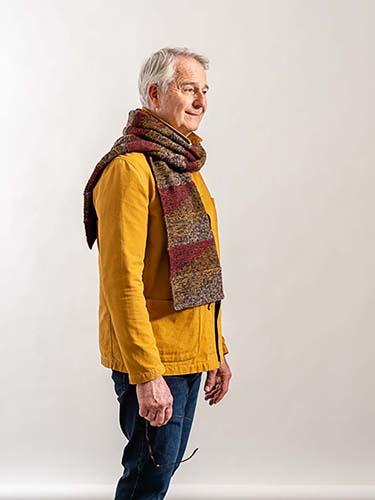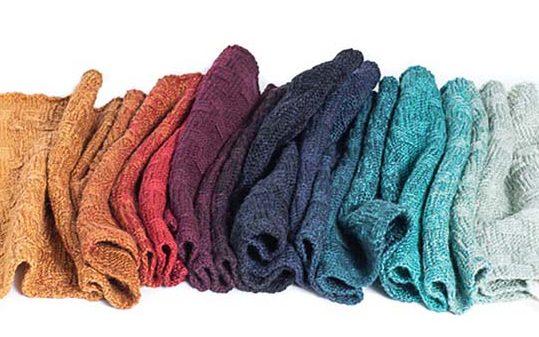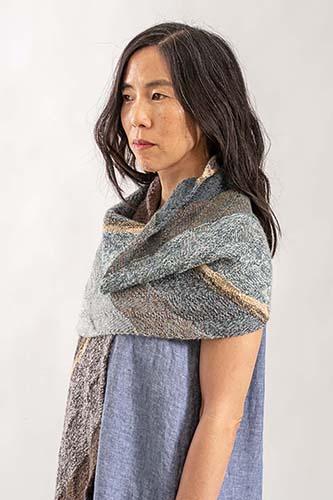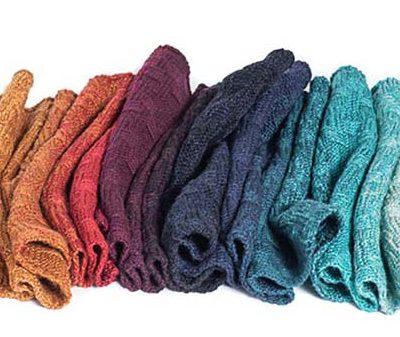









Books
Books with Franklin: Making Marls

“Books with Franklin” is not intended to be a column full of snap judgments. I’ve always intended it to give fiber arts books a level of scrutiny they seldom get, more than a quick riffle of the pages and a glance at the index. I have to get to know a book before I can write about it.
I have been getting to know Cecelia Campochiaro’s Making Marls: A Sourcebook for Multistrand Handknitting for well more than a month. I have lounged with it. I have lunched and dined with it. I have slept next to it, and once slept under it. I have read it in the bath and in the kitchen. I have put it on a book stand, because I am the sort of person who has a book stand, and imagined myself to be a Renaissance prince squinting at the latest scholarly treatise to come out of Leipzig.
I have spent so much time toting this hefty book around that I really wish it had come with four wheels and a string, so that I could pull it behind me like a toy horse.
Marls Without Snarls
If you know Campochiaro’s début work, Sequence Knitting, then you are somewhat prepared for what’s going to come at you in Making Marls. Sequence Knitting hit the scene like a time bomb with a slow ticker. Nobody knew about it. Nobody knew about it. Nobody knew about it. AND THEN EVERYBODY KNEW ABOUT IT.
The wild success of Sequence Knitting was all the more remarkable in that, according to the usual rules for Making a Knitting Book, it did everything wrong. There were a lot of words, many of them big words. There were a lot of mathy, mathy numbers. There were no pictures of anyone in a sweater on a cliff in the Shetland Islands. In fact, most of the pictures were of swatches. Swatches in pale colors. You Can’t Do That, say the rules. Knitters hate swatches. Knitters don’t want to buy a book full of swatches. You might as well present them with a picture album called Moths I Have Known.

The pattern: Stella, a study in staggered marl stripes.
But Campochiaro self-published her book, which meant she answered only to herself. The result was a dazzling, unclouded reflection of a steel-trap mind engaged in the creation of new hand-knit fabrics. Without wishing (much) to pick on the fine editors who shepherd fine books, sometimes it’s nice to let a writer who knows exactly what she wants to say go ahead and say it.
If you picked up Making Marls without looking at the title page, you’d know in a minute that it’s another Cecelia Campochiaro production.

Munsell: two strands of lace weight held together to create a fingering weight marl.
The topic this time is marled knitting–creating fabrics that are ultimately based on two or more strands of yarn held together and worked as one composite yarn.
I know what marled knitting is because the book begins with the definition. It’s on page 2, and takes up all of page 2. It could have been on page 1, but that’s where the chapter title is. So it’s on page 2. It’s the most logical thing with which to begin, and this author’s greatest strengths are the logic and organization she displays when noodling around with her ideas.
From one small question–What happens if I knit with more than one yarn?–she goes on to present blessedly clear and well researched investigations of the history of marled yarns, color theory and marled yarns, color value and marled yarns, marling sequences both simple and complex, microswatching* and practical concerns such as How the Hell Do You Set Yourself Up to Knit with Ten Strands Without Killing Yourself or Those You Love.

Rialto: Four strands of cobweb held together to create a sport weight marl.
Nothing is rushed, nothing is overlooked. There are swatches, so many swatches, arranged in meaningful rows and columns. There are tables, so many tables. Every path is pursued calmly, to its end, and in such a gentle upward grade that you don’t even realize you’re climbing a mountain until you hit the summit.

Taddeo: two strands of lace weight held together to create a DK weight marl.
That said, there are moments when you wonder if sometimes there’s too much of a good thing. Will a newbie who’s never really thought about the color wheel have the fortitude to tackle the chapter on color harmonies?
Maybe not. But if that curious newbie is interested enough to have this book on the shelf in the first place, she’ll find a toe-hold–perhaps in the discussion of marling and texture or perhaps simply by following one of the patterns with yarns she has to hand. And she’ll play around, and learn something, and have a lovely time–and come back for more. And she’ll get to the summit, eventually.
*“Microswatching is fast prototyping for slow knitting.” Page five. The first time in this book my heart skipped a beat. I have pressed a violet there, in remembrance.


Starting the week with Franklin is a delight!
O. M. G. You GET her!!! I took a class with Cecelia Campochiaro last January because I was intrigued with Sequence Knitting- and will never miss an opportunity to do so again. I think for many reasons now more than ever (pardon the expression) there’s a deep hunger for logic and a steel trap mind. Making Marls does not disappoint. Thank you for this stunning review!
In the beginning, one of the very few knitted items I was ever complimented on was a marled headband I just took it in my head one day to throw together. I think it was because of the sheer LIFE that jumped out of it. It certainly didn’t have any other sterling qualities. I wonder if that quality is what drew Cecilia toward tackling marls in such a thorough fashion? Such a wonderful aspect of knitting. Thanks Franklin for giving this book its due.
I love your writing so much <3. And yes please, show me your moths, I can show you mine. I have more photos of bugs on my phone than I do of my kids lol.
Back in January (that seems so long ago now) I knit 4 marled tuques using Tin Can Knits’ fun Snap Hat pattern. They were so satisfying and enjoyable.
Your review makes me want to do some marling on a larger scale. Thanks for the insight!
PS – I believe there is an error on the description below the RIALTO shawl photo. It states that 2 strands of cobweb are used to create a sport weight yarn.
I know it seems odd but that is what it says on the pattern page on Ravelry! Captions are ours, not Franklin’s, by the way. Cobweb sounds scary to me, even doubled!
Hi I checked the Rialto Ravelry pattern page and it calls for 4 strands of cobweb to create a sport weight.
And yes that sounds a little scary. I’m sure I would have a tangled mess in no time!
I think it should say 4 strands of cobweb held together according to the Ravelry pattern page.
Love reading Franklin’s articles; I’m currently waiting for delivery of my 4th book based on his recommendations. All so far have been wonderful.
Fabulous!
Hooboy, this is a great review and perfectly timed. I attended Cecelia’s Marls lecture on Vogue Live yesterday and have the do-it class tonight. This follows her Sequencing class Saturday night. Color me a new groupie in the Cecelia Camp and in Franklin’s group as well! Thanks for an awesome start to the week.
I guess my Mom was ahead of her time. She used knit two colors together frequently. One of my favorite sweaters in junior high was a hunter green and tan cardigan that she knit. This was 1963.
Always a delight! Toy horse indeed!
My sister’s mother-in-law often knit with multiple strands of fine yarn to make whatever weight yarn she wanted. Sometimes in one color, sometimes mixed. Beppe Reena was from Friesland in Holland.
She talked about the micro-swatching in her VKLive lecture yesterday. My heart, too, went, wait..WHAT? You can do that?!?
Great review and so funny. I’ll definitely have to read more Books with Franklin posts. As for Making Marls, it is everything you said it was and so inspiring. I bought it a week ago and as soon as I started reading it, I began to have ideas for projects I need to make with yarn that has been waiting in my stash for just the perfect idea. Should finish my current WIP today, then it’s on to microswatches. Color wheel theory was a bit beyond me. I’ll have to come back for that when I need to know more.
One of my favorite books. Until Cecelia’s next one!
It’s a really good knitting book. I don’t buy knitting books much anymore, but I bought this one and I am thrilled with it.
I never much cared for marled yarns in skeins, but this is really a game changer. Cecilia is a genius. Thanks for the wonderful review, Franklin.
I have also taken to this book because it was expensive and it is worth every single penny. I underline things in pencil because the book is so beautiful . I so, so wish that Elizabeth Zimmerman were here to read it to us and to marvel at the genius of this knitter
Microswatching!! Heart eyes!!
Lovely review, as usual. I was surprised to see that for the four patterns pictured, Ravelry lists a total of one project. Three have zero projects. But I guess this book is read for technique, not projects. I’ve marled a lot over the years, mostly because I don’t like knitting with very lightweight yarns but still buy some that are too beautiful to resist. Combining them solves this problem. It’s like making your own yarn for non-spinners.
“It’s like making your own yarn for non-spinners.” Exactly!! This is the description I have been looking for to explain why marling is so satisfying. Thanks!
That pressed violet slayed me. Another chuckle of a read, with actual content to boot! You’re the best, Franklin.
Absolutely love your writing – I am not a veteran knitter but new to this wonderful world of color, texture and pleasure. One of the most wonderful things is getting to know a whole new world of writers – you are one of the best!
This was the best book review I can remember reading ever. Inspiring!
It’s not only a knitting book but a book for color nerds, too. I’d love to make some of the things, but just looking at the microswatches gives me such pleasure.
Your writing is wonderful! You painted a wonderful picture of you exploring this book. I felt drawn into your experience. I’m a life long crocheter and fine artist, but a newbie to knitting. You’ve helped me feel so very excited about taking on a new technique. Thank you.
I knit a favorite sweater with a marled yarn. It had 3 plies using hand painted yarns. It’s a scrumptious effect.
I so look forward to Snippets every week, especially now with the way of things being what they are…. but to start my day with a review by Franklin on a book I am enchanted by was way over the top….thank you for the bright spot, the happy read, the smile…I wish back the same for you!!!
I took the Making Marls class with Cecilia at A Yarn Less Raveled And it was the best thing ever! I love her style. ❤️
i loved this. i discovered i have been marling for years and didn’t know it.